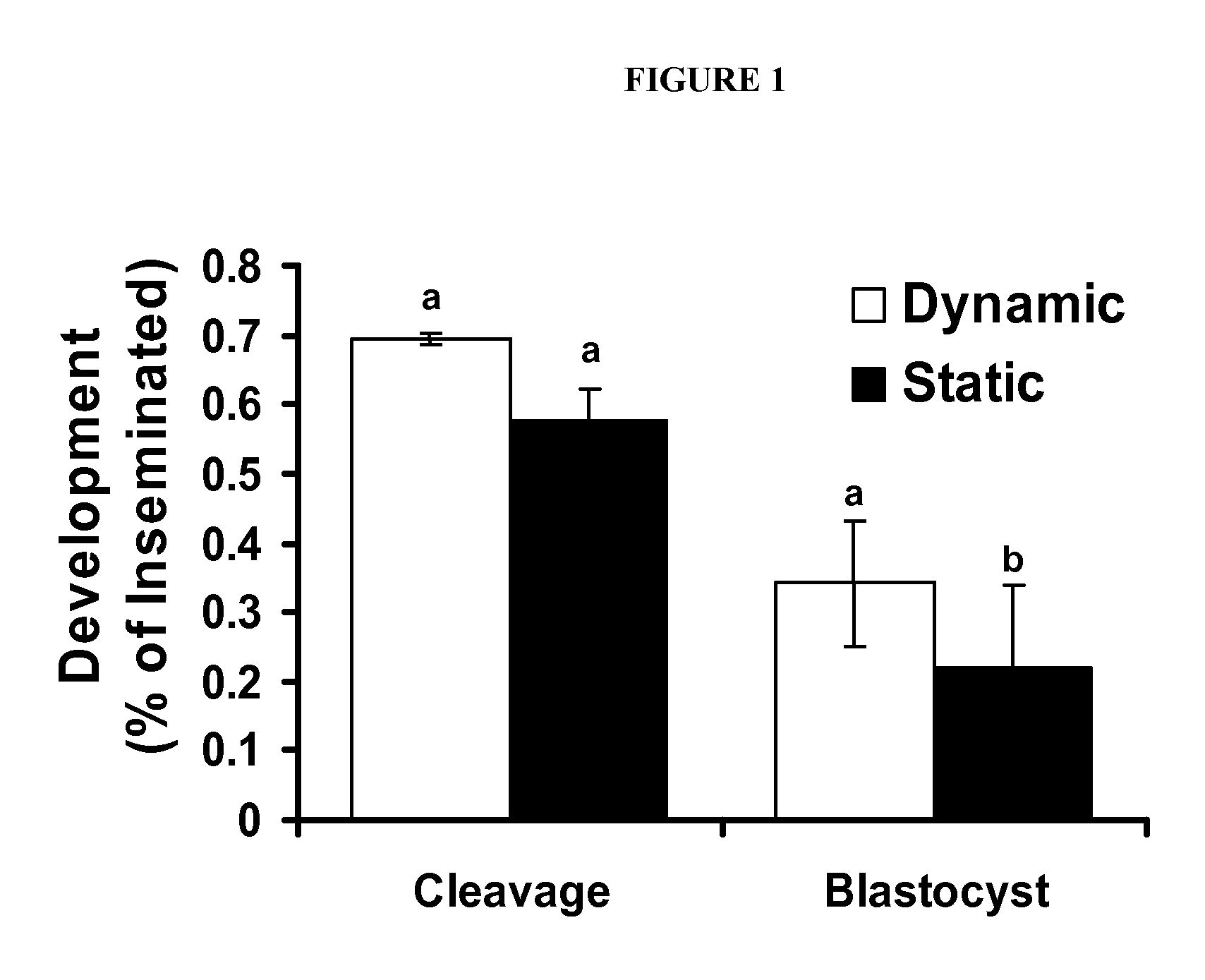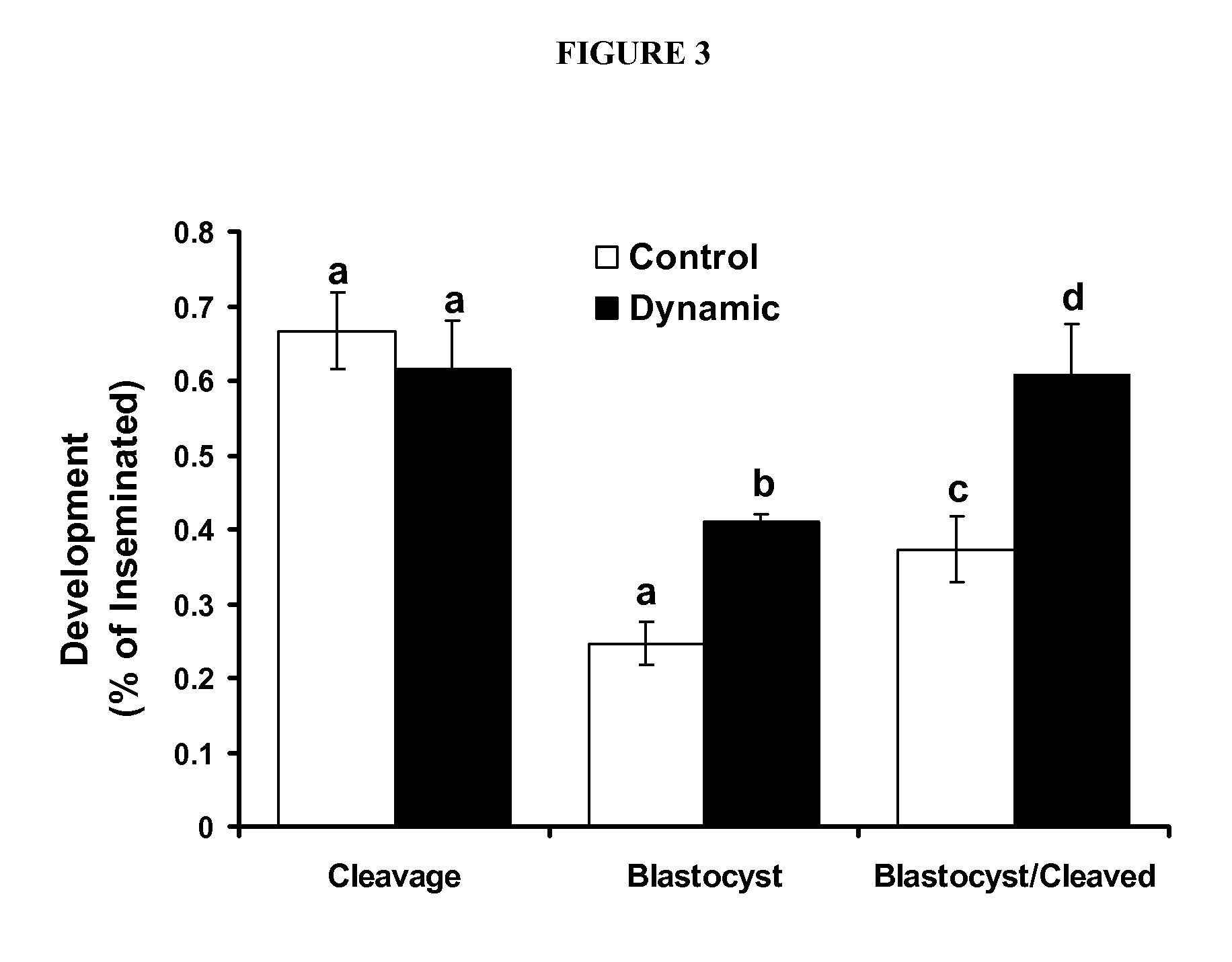Methods for in vitro oocyte maturation
a technology of in vitro oocytes and oocytes, which is applied in the field of assisted reproduction technology in mammals, can solve the problems of detriment to the subsequent normal function of oocytes in a static soluble environment, and achieve the effects of reducing metabolic waste, reducing metabolic waste, and high metabolic activity
- Summary
- Abstract
- Description
- Claims
- Application Information
AI Technical Summary
Benefits of technology
Problems solved by technology
Method used
Image
Examples
example 1
Development of Bovine Blastocysts Following In vitro Oocyte Maturation, Fertilization and Embryo Culture on a Microfluidic Platform
Materials and Methods
[0080]Bovine ovaries were obtained from a local abattoir and transported to the laboratory within 2 h of collection at 32-37° C. Ovaries were rinsed twice with warmed 0.9% saline. Cumulus oocyte complexes (COCs) were aspirated from antral follicles (2-10 mm in diameter) using an 18-gauge needle (Vetpharm, Sioux Center, USA). Only COCs having at least three layers of non-expanded cumulus and an even distribution of cytoplasm were selected. Oocytes were washed three times in HEPES buffered medium supplemented with 1.0% v / v PSA (100 units / ml penicillin, 100 μg / ml streptomycin, 0.25 ng / ml amphotericin, Gibco, Grand Island, N.Y.) and once in maturation medium (TCM-199). Selected COCs were matured in tissue culture medium 199 (TCM-199; Gibco, Grand Island, N.Y.), supplemented with 10% fetal calf serum (FCS; Gibco,...
experiment 1
Effect of Dynamic Culture on Oocyte Nuclear Maturation
[0086]The first experiment was designed to determine the effect of dynamic culture during oocyte maturation on the rate of oocytes reaching Metaphase II. Oocytes were randomly divided into groups of 10 in 50 pl drops of maturation media in culture dishes, microfluidic chips without dynamic flow and on microfluidic chips with dynamic media flow. At 22 h post maturation, oocytes were denuded and chromatin stained as previously described to assess stage of meiosis. Each treatment group was replicated at least 3 times.
experiment 2
Effect of Dynamic IVM on Subsequent Blastocyst Development
[0087]Experiment 2 was designed to determine the effect of dynamic culture on oocyte maturation and subsequent embryo development. Oocytes were randomly allocated into groups of 10 in 50 pl drops of maturation media in culture dishes, microfluidic chips without dynamic flow and on microfluidic chips with dynamic media flow. Oocytes were inseminated and all zygotes / embryos independent of previous IVM conditions were cultured under identical conditions on static culture dishes as previously described. Development and total cell count was measured on day 7 of embryo culture. Each treatment group was replicated at least 3 times.
PUM
| Property | Measurement | Unit |
|---|---|---|
| flow rate | aaaaa | aaaaa |
| flow rate | aaaaa | aaaaa |
| flow rate | aaaaa | aaaaa |
Abstract
Description
Claims
Application Information
 Login to View More
Login to View More - R&D
- Intellectual Property
- Life Sciences
- Materials
- Tech Scout
- Unparalleled Data Quality
- Higher Quality Content
- 60% Fewer Hallucinations
Browse by: Latest US Patents, China's latest patents, Technical Efficacy Thesaurus, Application Domain, Technology Topic, Popular Technical Reports.
© 2025 PatSnap. All rights reserved.Legal|Privacy policy|Modern Slavery Act Transparency Statement|Sitemap|About US| Contact US: help@patsnap.com



